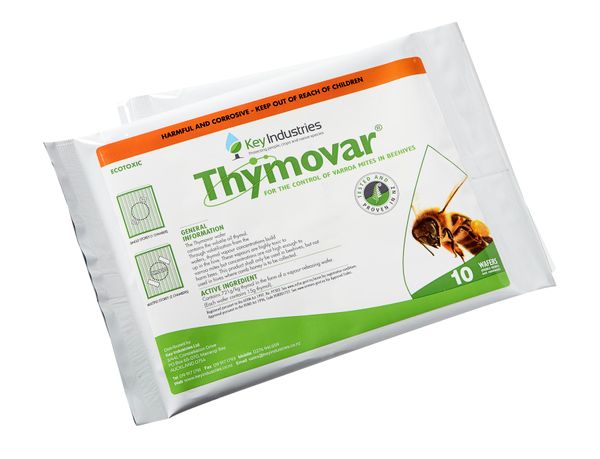
Thymovar Wafer pack
Description
For the control of varroa mites in beehives.
Active ingredient: contains 721g/kg thymol in the form of a vapour-releasing wafer. (Each wafer contains 15g thymol).
The Thymovar wafer contains the volatile oil thymol. Through volatilization from the wafers, thymol vapour concentrations build up in the hive. These vapours are highly toxic to varroa mites but concentrations are not high enough to harm bees.
This product shall only be used in beehives, but not used in hives where comb honey is to be collected. Registered pursuant to the ACVM Act 1997, No. P7303 See www.foodsafety.govt.nz for registration conditions. Approved under the Animal Products (Ancillary and Transitional Provisions) Act 1999. Approved pursuant to the HSNO Act 1996, Approval Code: HSR001727 See http://www.epa.govt.nz for approval controls.
Not for use when honey supers are present in the hive.
Dosage rate: Two applications of one wafer per brood chamber at a 3-4 weeks interval. Open the sealed sachet containing 5 wafers. Place one wafer (cut in half) on top of the brood chamber. Use two wafers uncut for a double storey box of chambers. Wafers can be cut with a pair of scissors.
Application: The first part of the treatment is to put the wafer(s) on the top of the combs of the brood chamber. Close the hive as usual. Open floors have to be closed. Repeat the application of wafer(s) 3-4 weeks later. Remove used wafers after 3-4 weeks. After opening the sealed sachet all wafers should be used immediately.
Timing: Application can be made in the spring before honey supers have been added for the first honey flow. Alternatively, an application can be made in the late summer to early autumn period immediately after all the surplus honey has been removed. Apply when maximum daily temperatures are between 12°C and 30°C. All hives of an apiary should be treated with Thymovar at the same time, to avoid robbing. Factors such as temperatures dropping below 12 °C for a longer period during the treatment can lower the effectiveness of treatment. Also temperatures higher than 30 °C increase the sublimation of the thymol, and can have negative effects on the bees (e.g. robbing). It is recommended that the natural mite fall be monitored 2 weeks after completion of the Thymovar treatments and if more than 1 mite per day is recorded alternative non-thymol based treatments be applied. If the mite drop is not checked, all colonies have to be subjected to a follow-up treatment. Otherwise sufficient efficacy for all colonies cannot be guaranteed.
